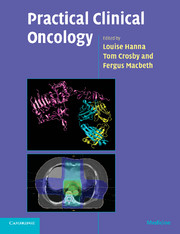Book contents
- Frontmatter
- Contents
- List of contributors
- Preface
- Acknowledgements
- Abbreviations
- 1 Practical issues in cytotoxic chemotherapy usage
- 2 Biological treatments in cancer
- 3 Hormones in cancer
- 4 Radiotherapy planning
- 5 Research in cancer
- 6 Oncological emergencies
- 7 Palliative care
- 8 Head and neck
- 9 Oesophagus
- 10 Stomach
- 11 Liver, gallbladder and biliary tract
- 12 Exocrine pancreas
- 13 Colon and rectum
- 14 Anus
- 15 Gastrointestinal stromal tumours
- 16 Breast
- 17 Kidney
- 18 Bladder
- 19 Prostate
- 20 Testis
- 21 Penis
- 22 Ovary
- 23 Body of the uterus
- 24 Cervix
- 25 Vagina
- 26 Vulva
- 27 Gestational trophoblast tumours
- 28 Lung
- 29 Mesothelioma
- 30 Soft tissue and bone tumours in adults
- 31 The lymphomas and myeloma
- 32 Central nervous system
- 33 Skin cancer other than melanoma
- 34 Melanoma
- 35 Thyroid
- 36 Neuroendocrine tumours
- 37 Cancer in children
- 38 Cancer of unknown primary
- 39 The use of radiotherapy in the treatment of benign conditions
- Multiple choice questions
- Multiple choice answers
- Index
- References
14 - Anus
Published online by Cambridge University Press: 23 December 2009
- Frontmatter
- Contents
- List of contributors
- Preface
- Acknowledgements
- Abbreviations
- 1 Practical issues in cytotoxic chemotherapy usage
- 2 Biological treatments in cancer
- 3 Hormones in cancer
- 4 Radiotherapy planning
- 5 Research in cancer
- 6 Oncological emergencies
- 7 Palliative care
- 8 Head and neck
- 9 Oesophagus
- 10 Stomach
- 11 Liver, gallbladder and biliary tract
- 12 Exocrine pancreas
- 13 Colon and rectum
- 14 Anus
- 15 Gastrointestinal stromal tumours
- 16 Breast
- 17 Kidney
- 18 Bladder
- 19 Prostate
- 20 Testis
- 21 Penis
- 22 Ovary
- 23 Body of the uterus
- 24 Cervix
- 25 Vagina
- 26 Vulva
- 27 Gestational trophoblast tumours
- 28 Lung
- 29 Mesothelioma
- 30 Soft tissue and bone tumours in adults
- 31 The lymphomas and myeloma
- 32 Central nervous system
- 33 Skin cancer other than melanoma
- 34 Melanoma
- 35 Thyroid
- 36 Neuroendocrine tumours
- 37 Cancer in children
- 38 Cancer of unknown primary
- 39 The use of radiotherapy in the treatment of benign conditions
- Multiple choice questions
- Multiple choice answers
- Index
- References
Summary
Introduction
Anal cancer, like carcinoma of the cervix, is strongly associated with human papilloma virus (HPV) infection. In the past few decades, treatment has swung away dramatically from primary surgery to definitive chemoradiotherapy, with the evident physical and psychosocial benefits of organ preservation. Tumours of lower stage T1 or T2, N0, have an excellent outcome with the chemoradiotherapy approach. Unfortunately, many patients present with T3, T4 or N ≥ 1 disease and they have a significant risk of both locoregional and subsequent distant failure. Half of patients still die within 5 years of treatment. Therefore, efforts are ongoing to improve outcomes via better local and systemic therapy.
Types of anal tumour
Types of anal tumour are shown in Table 14.1.
Anatomy
The anal canal extends from the rectum to the junction of the hair-bearing skin of the perianal region. It is 3 to 4 cm long and its walls are kept in apposition by the sphincter muscles, except during defaecation. The anal margin is the perianal skin immediately adjacent to the distal limit of the anal canal. The anal verge is the lower end of the anal canal.
The tumours can be divided into three types:
Anal-margin tumours are usually small and well differentiated and are more common in men.
Anal-canal tumours are more common than those at the anal margin. They are more common in women (male-to-female ratio ∼1:2.5), are often moderately or poorly differentiated, and carry a worse prognosis.
Dual-component tumours have both anal-margin and -canal components and it is not possible to define from where the tumour originated. These comprise the majority of tumours.
- Type
- Chapter
- Information
- Practical Clinical Oncology , pp. 174 - 182Publisher: Cambridge University PressPrint publication year: 2008



